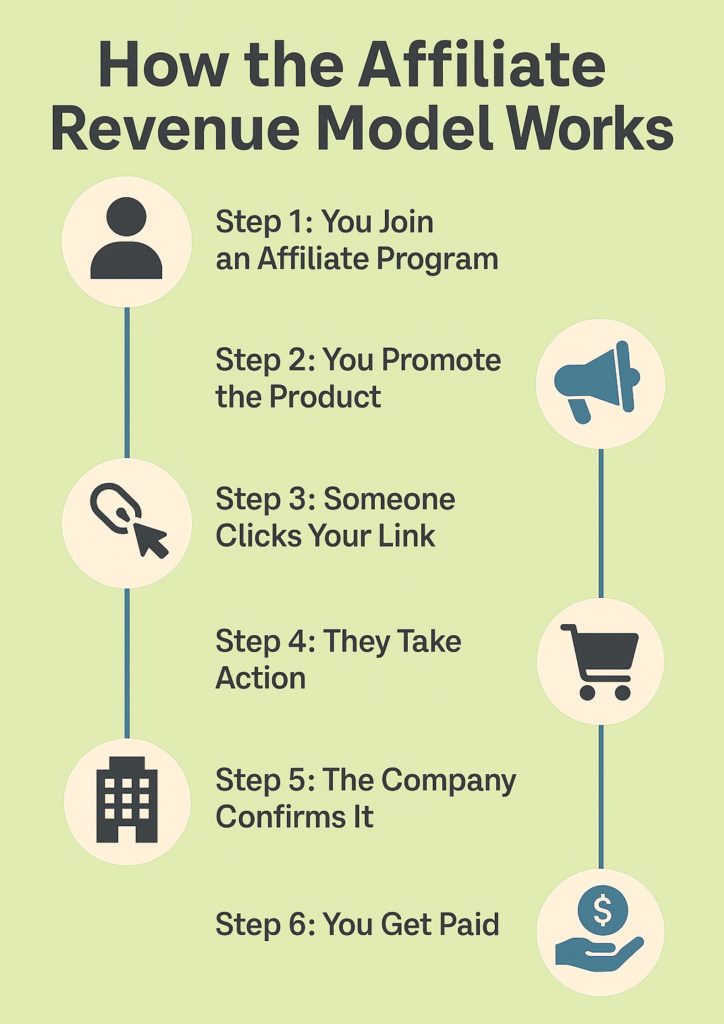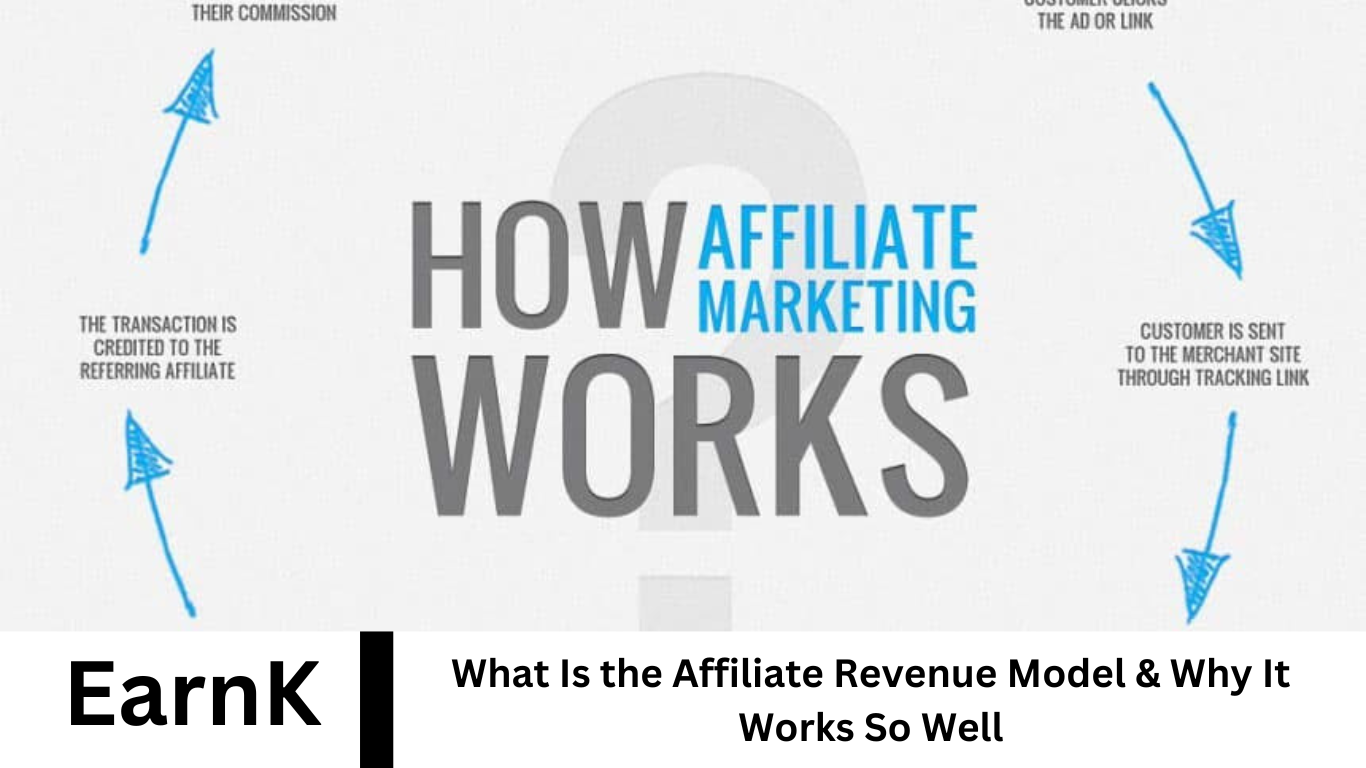The affiliate revenue model is one of the most popular and effective ways to earn money online in 2025. It’s a performance-based marketing strategy where individuals (affiliates) earn commissions by promoting products or services from other companies. You don’t need to create your own product—just connect the right audience with the right offer using your content, links, or platforms like blogs, YouTube, or social media. It works well because it’s low-risk, cost-effective, and scalable.
What is the Affiliate Revenue Model?
The Affiliate Revenue Model is a performance-based marketing strategy in which individuals or businesses (affiliates) earn a commission for promoting another company’s products or services. The affiliate promotes the product through a unique tracking link, and when someone makes a purchase or takes a specific action (like signing up or downloading), the affiliate receives a reward—usually a percentage of the sale or a fixed amount.
Read more: Join the Best MCX Telegram Commodity Channel for Live Signals and Expert Tips
Who’s Involved in the Affiliate Revenue Model?
There are four key players in the affiliate marketing ecosystem:
- The Merchant (Advertiser/Product Owner)
This is the business or brand that owns the product or service. They offer the affiliate program to boost sales through external promoters. - The Affiliate (Publisher/Marketer)
This is the individual or company that promotes the merchant’s product using various methods like blogs, YouTube, social media, email marketing, etc. Affiliates earn commissions for each successful referral. - The Consumer (Customer/Buyer)
The end-user who clicks on the affiliate link and completes the desired action, such as making a purchase or signing up. - The Affiliate Network (Optional Middleman)
Some programs operate through affiliate networks like ShareASale, CJ, ClickBank, or Amazon Associates. These platforms manage tracking, reporting, and payouts between merchants and affiliates.
How the Affiliate Revenue Model Works – Step-by-Step
Here’s a simplified step-by-step process of how this model operates:

- Merchant Creates an Affiliate Program: A business sets up a system to track referrals and assign commissions.
- Affiliate Joins the Program: The marketer signs up, gets approved, and receives a unique affiliate tracking link.
- Promotion Begins: The affiliate shares the link via blogs, social media, videos, or paid ads.
- Customer Clicks the Link: A user clicks the affiliate link and is directed to the merchant’s site.
- Action is Taken: If the user completes a specific action (like a purchase or form submission), it’s tracked using cookies and analytics.
- Affiliate Gets Paid: Once the action is verified, the affiliate earns a commission, which is paid out according to the program’s terms (weekly, monthly, etc.).
Types of Affiliate Revenue Models
There are several payout structures within the affiliate revenue model:
- Pay-Per-Sale (PPS)
The affiliate earns a commission every time a referred user makes a purchase. - Pay-Per-Click (PPC)
The affiliate is paid based on the number of users who click on their affiliate links, regardless of whether a sale occurs. - Pay-Per-Lead (PPL)
Commissions are earned when a referred user completes a specific action, like filling out a form, signing up for a free trial, or downloading an app. - Recurring Commission
Affiliates earn ongoing commissions as long as the referred customer continues using a subscription-based product or service. - Two-Tier Affiliate Programs
Affiliates can also earn commissions by referring new affiliates to the program, essentially earning from their downline’s performance.
Benefits of the Affiliate Revenue Model
- Low Cost of Entry: Affiliates don’t need to create products or handle customer service.
- Scalable Income: You can promote multiple products across platforms and earn from each one.
- Flexible Work Schedule: Affiliates can work from anywhere and at their own pace.
- Performance-Based: You earn more when you perform better—perfect for those who are results-driven.
- Win-Win for Both Sides: Merchants get more customers, and affiliates earn money for helping them grow.
- No Inventory Management: Since you’re not selling your own product, there’s no hassle of storage or shipping.
Read more: Affiliate Marketing Landing Page Guide: Types, Tools & Examples
Tips to Succeed in Affiliate Marketing
- Choose the Right Niche: Focus on a topic you understand and where there is a demand for products.
- Promote Quality Products: Only recommend items that offer real value—this builds trust with your audience.
- Build an Audience: Use blogs, YouTube, Instagram, or email lists to attract and engage your followers.
- Be Honest and Transparent: Always disclose your affiliate relationships. It’s required by law and builds credibility.
- Leverage SEO and Content Marketing: Create valuable content that ranks in search engines and naturally promotes your links.
- Use Data to Improve: Track your clicks, conversions, and commissions to understand what works and optimize your strategy.
- Test and Adapt: Experiment with different promotional methods—like email marketing, video content, or paid ads—and scale the ones that perform best.
- Stay Updated: Follow trends, product updates, and changes in affiliate terms to stay competitive.
Frequently Asked Questions
What is the affiliate revenue model?
It’s a system where affiliates earn a commission for promoting another company’s product or service.
How does an affiliate get paid?
Affiliates earn money when users click their unique link and complete a desired action—like purchasing or signing up.
What platforms can I use for affiliate marketing?
You can use blogs, YouTube, Instagram, Facebook, email lists, or even messaging apps like WhatsApp and Telegram.
Is affiliate marketing passive income?
It can become passive once your content ranks or circulates, bringing in recurring commissions without constant effort.
Do I need to invest money to start?
No. Many affiliates start for free using social media, although paid tools can help scale faster.
What types of products can I promote?
Anything—from digital tools, online courses, and software to physical products like books, gadgets, and fashion.
Are affiliate earnings taxable?
Yes. Like any income, affiliate commissions are subject to taxation based on your country’s laws.
How do companies track my referrals?
They use cookies and unique affiliate links to monitor clicks, sales, and actions tied to your promotions.
What’s the average affiliate commission rate?
Rates vary—physical products may offer 5–10%, while digital products often offer 20–50% or more.
Can anyone become an affiliate marketer?
Yes. No degree or experience is required—just a willingness to learn, promote, and provide value.
Conclusion
The affiliate revenue model continues to thrive because it benefits everyone—businesses get more sales, and affiliates earn by sharing useful products. It’s a low-barrier, low-risk way to start generating income online, whether as a side hustle or full-time venture. The key to long-term success is trust, consistency, and choosing quality offers that match your audience. With the right strategies, you can create sustainable passive income streams through content, email, or social media platforms. As more people shop and learn online, affiliate marketing will only grow stronger.



